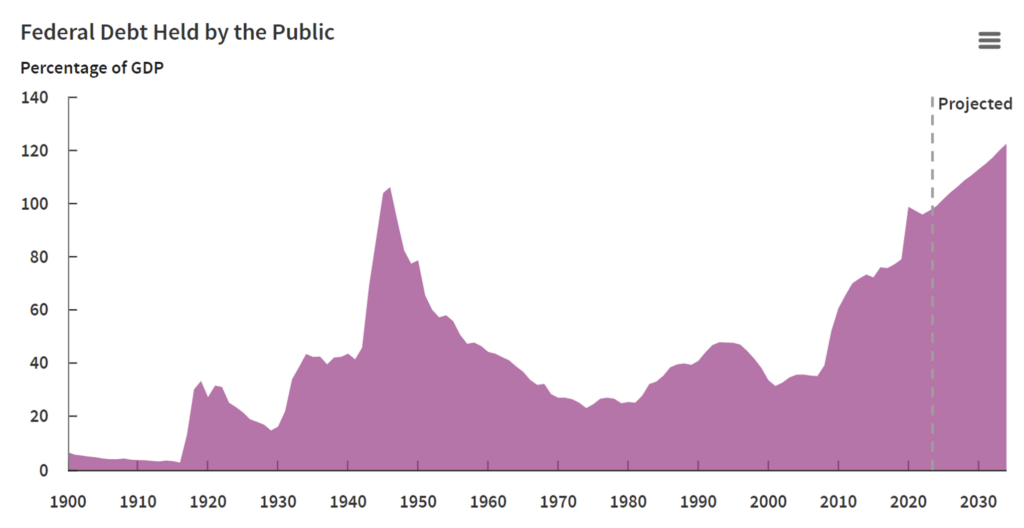The federal debt is on track to surpass annual economic growth for the first time in nearly 60 years. The Congressional Budget Office (CBO) forecasts the national debt held by the public to account for over 100% of gross domestic product by 2025. This growing imbalance comes despite the country notching its highest economic output in history in 2023 with $27 trillion. Generally, high debt-to-GDP ratios signal serious economic issues and unsustainable growth.
Growth of Debt to GDP

Past — Between 1973 and 2023, public-held debt took up an average of 48.3% of GDP. After half a century, this key economic metric has crossed over this average.
Present — In 2023 and 2024, the public has held 97% and 98% of the national debt, respectively. Estimates suggest debt will blow past total economic output by 2025 for the first time since WWII.
Future — The CBO report indicates national debt will climb over 106% by 2027 and reach 122.4% by 2034. Alarmingly, forecasts suggest this surge will continue unabated in the foreseeable future.
Top Expenses
Here’s how the most expensive pieces of the national budget breakdown:
- Social Security — $1.45 trillion
- Medicare — $903 billion
- Defense — $849 billion
- Interest Payments — $892 billion
Spending Issues
Politicians might try to deflect from their complicity in the debt problem, but their fingerprints are all over it. Consider that the previous four administrations operated a collective net loss of $26 trillion.
- Joe Biden – $4.3 trillion
- Donald Trump – $8.1 trillion
- Barack Obama – $8.3 trillion
- George W. Bush – $6.1 trillion
That’s nearly 75% of the current debt level! According to the CBO report, this spending treadmill shows no signs of slowing down. Federal expenditures are projected to gobble up nearly 25% of GDP by 2034. At the same time, tax revenue is only supposed to reach 18% of GDP. Clearly, the federal debt isn’t a revenue problem; it’s a spending problem. The US government has been overprinting and overspending with impunity for years on end.
The Behind-the-Scenes Culprit
Both parties and political candidates remain decidedly mum on debt matters, revealing a bipartisan nature to the federal spending machine. In reality, the federal government, especially fiscal leaders, has embraced a monetary policy that champions printing and spending as real solutions to economic problems. Known as Modern Monetary Theory (MMT), this experimental approach doesn’t see debt as an issue which explains why the political class seems so comfortable driving debt to unprecedented levels. In this context, debt is correctly viewed as a feature of our current economic system rather than a bug.
Investors At Risk
Billionaire David Rubenstein recently compared the debt crisis to a “grenade ” being tossed down through generations until it explodes. Inevitably, the average American will suffer the brunt of the damage. The full scale of the fallout is unpredictable, but investors are already burdened by a growing number of challenges. Dollar devaluation, aggressive rate cuts, stubborn inflation, global de-dollarization, and regional wars are all threatening the financial health of investors.
With MMT at the reins, the end of this debt path is more likely a cliff than anything resembling a “soft landing.”
“Trusting the Federal Reserve to be able to make the changes to help is a bad strategy. People need to safeguard their assets so they don’t lose them in the coming financial problems.”– Todd Graf, Precious Metals Advisor at Scottsdale Bullion & Coin


